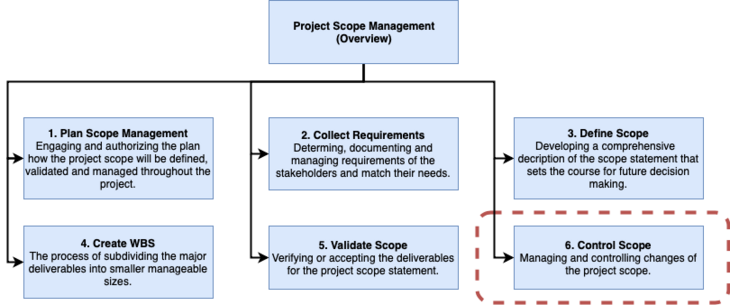Project Scope Control Management
Contents |
Abstract
In an ideal world, once a scope has been defined and moved into prototyping and construction, no changes will be made to the requirements or the extent, but in reality, project scope is continuously evolving over the entire lifecycle of the project. Therefore, it is significantly important that the scope identifies all the work that the project will accomplish to achieve its final goal and have a clear and easy scope management process that refers to the set of various processes that ensure a project's scope is accurately defined and mapped. [1] It is essential at the start of the project scope that it consists of sufficient detail to determine the purpose of the project with the expected benefits and any constraints such as time and budget. The Project Scope Management (PSM) processes consists of six parts, where control scope is the last part and is the process of monitoring and controlling the status of the product and project scope including managing changes to the scope baseline. [1] The product scope refers to how a product is made while a project scope focusses more on how to deliver the service or product. [2] The advantage of control scope is that it allows the baseline to be maintained throughout the entire project. Without a well-defined project scope, the time and cost of the project cannot be an estimation and obtained due to a lack of communication, which applies that the scope needs to be changed. This immediately affects the cost and disrupts the schedule of the project generating losses. This article focuses on achieving a successful project with the six main aspects of project scope management and including the scope change control and what changes may need to be proceeded to have a great scope. These aspects will be discussed in detail alongside the general guidelines of project scope management.
Introduction
Project Scope Management

The appearance from the abstract is that the controlling changes of the project scope are output from the control scope process which is a part of the project scope management process. The purpose of Project Scope Management is to assure that the results and the outcome of a project are successfully achieved by merely incorporating the necessary work to complete the project. Managing the project scope is mainly refers to defining and controlling what is included in the design and what is not.[1] Therefore, project scope management can be defined as a set of processes that requires to be done in order to complete a product with the described functions and features to achieve the desired project. [1]
Figure 1 provides an overview of the six important processes of the Project Scope Management with their task’s description highlighted by the PMBOK® Guide:[1]
1. Plan Scope Management
The first process is the plan scope management which is producing a scope management plan. The plan describes and documents how the project scope will be defined, validated and controlled. The essential part is that plan scope process helps and contributes guidance and orientation on how the scope will be managed throughout the entire project. Furthermore, the scoping plan also includes the different roles of people involved in managing the project scope and their responsibilities regarding the areas. Therefore, a guide helps to manage and control the scope. [1]
2. Collect Requirements
The collect requirements are an important process which is referred to as determining, documenting, and managing stakeholder demands and needs, but also requirements regarding the project objectives are met. From the stakeholder point, it is essential to breakdown their needs into a requirement. The element becomes the foundation for the WBS, which includes and referring to cost, schedule, planning, procurement which are all relying on the conditions. [1] Furthermore, the process provides the general definition of managing the project scope, these definitions are part of the scope baseline and are selected by the different stakeholders, project sponsor, project manager, who consider the requirements to be important.
3. Define Scope
The third process of the project scope management is to define the scope which consists of developing a well-detailed description of the project. The primary benefits of building a sufficiently detailed description of the scope is that it provides the foundation in the future for making project decisions. But this also provides a commen understanding of what the project scope is between the stakeholders. Besides having an explicit description of the project scope, it is also essential to include the different requirements from the stakeholders that have been developed in the collect requirements process and chosen to be the preferred requirements of the scope [3]. Furthermore, it is necessary to consider the known risks, constraints and assumptions to add the project scope.[1] All these points will have a significant contributor to the success and achievement of the project.
4. Create Work Breakdown Structure
5. Validate Scope
6. Control Scope

Scope Change Control

Application of Scope Change
Methodology
Change Request
Limitations
Glossary
References
- ↑ 1.0 1.1 1.2 1.3 1.4 1.5 1.6 1.7 Project Management Institute (2013). A Guide to the Project Management Body of Knowledge (PMBOK® Guide) 5th edition. Page 105
- ↑ 2.0 2.1 2.2 2.3 William R. Duncan. (2013). A Guide to the Project Management Body of Knowledge (PMBOK® Guide) 5th edition. Pennsylvania: Project Management Institute.
- ↑ Margaret Rouse. (January 2018). Project scope. [online].Available at: http://searchcio.techtarget.com/definition/project-scope